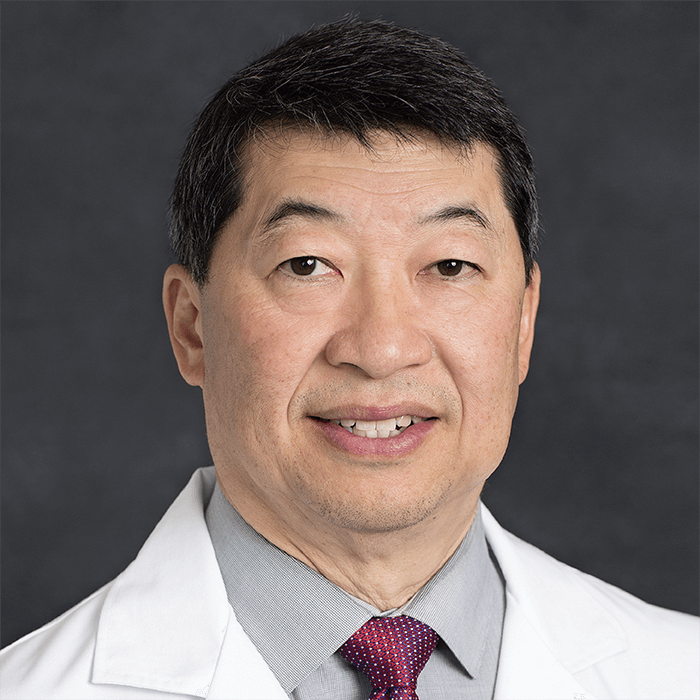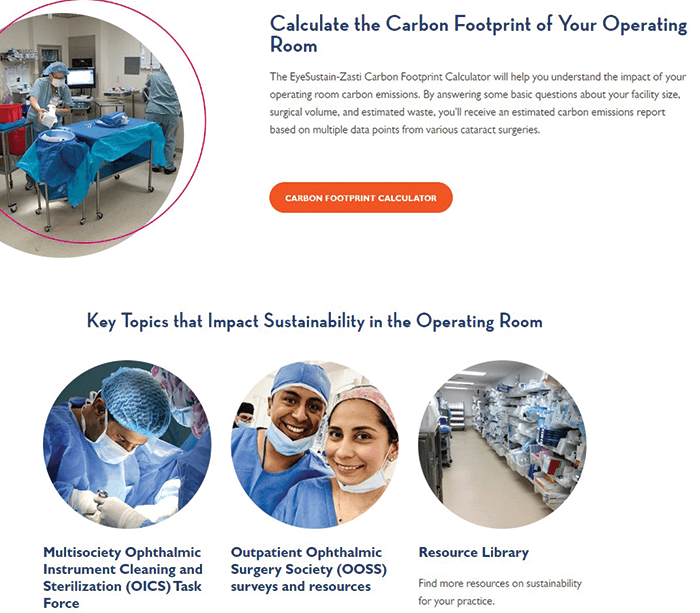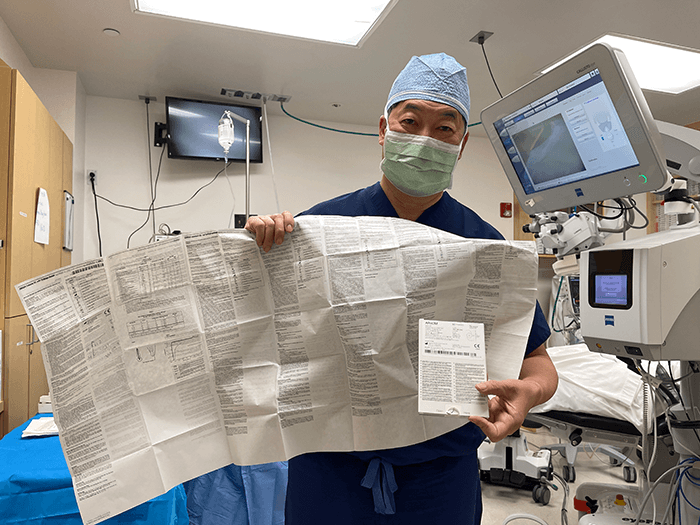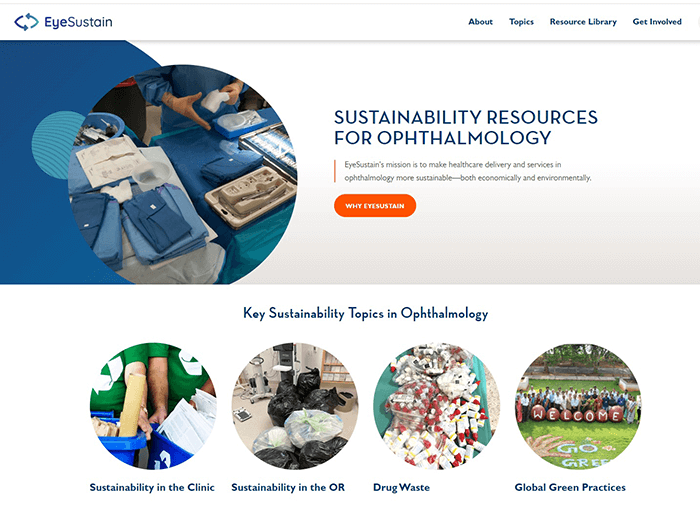
Why should ophthalmologists care about climate change?
In October 2021, in the middle of the pandemic of the century, the World Health Organization labelled the climate crisis the single biggest threat to global public health. This will disproportionately affect poorer countries and communities. The International Agency for the Prevention of Blindness predicts that global warming will increase trachoma, onchocerciasis, cataract, and other age-related disorders causing visual disability and blindness. This merits every physician’s attention, not just because climate change endangers public health, but also because the healthcare sector is a major contributor to carbon emissions worldwide. In the US, the healthcare sector is responsible for approximately 10 percent of our total carbon emissions, which is staggering. Perhaps the single largest source of this is our operating rooms where most supplies and many drugs are discarded after a single use. Although well over 90 percent of surveyed ophthalmologists are concerned about global warming and believe that surgical waste is excessive there are multiple obstacles to reducing the environmental impact of our procedures. These include multiple layers of rigidly enforced operating room regulations or manufacturer instructions for use that prohibit reuse of surgical supplies and intraocular drugs. Some of these requirements, like discarding one’s gown following every case, make sense for general surgical procedures but are of unproven benefit for ophthalmic surgery where there is no contamination with tissue or bodily fluids. Our specialty boasts the highest procedural volumes in medicine, and this will steadily increase in the decades ahead. We therefore have an obligation to reduce needless waste that imperils the financial and environmental sustainability of the vital services that we provide.
This is why a group of us created EyeSustain, a new web- and app-based platform to educate, engage, and network our profession to make eye care and surgery more economically and environmentally sustainable. With initial support from ASCRS, EyeSustain.org was launched on Earth Day at the 2022 ASCRS annual meeting. For the first time, the global ophthalmic community can freely access information and resources on sustainability – previously scattered among multiple sites – at one central location.
Are there any models for delivering sustainable eye care?
The Aravind Eye Hospital system in India routinely reuses surgical gowns, gloves, irrigation bottles, IA tubing, cannulas, blades, sutures, and intraocular drugs. Conserving resources allows them to provide 60 percent of their surgeries at no cost to the indigent population in southern India. This also reduces the carbon footprint of a single phaco at Aravind to 5 percent of that from a single phaco performed in the UK or the US (1). We reported an endophthalmitis rate of 0.04 percent in 2 million consecutive cataract surgeries at Aravind where these supplies are routinely reused (2). The AAO IRIS registry reported an identical endophthalmitis rate of 0.04 percent during a similar time frame in the US. This tells us that the enormous financial and environmental cost of mandating single use of these same supplies for every procedure in the US is not reducing the infection rate. However, American licensing and accrediting organizations consider reusing these supplies to be so dangerous that surgical facilities would be shut down for repeated violations of these single use mandates. The resulting waste is massive and without proven necessity.
How many ophthalmologists share your opinions about OR waste?
Cassandra Thiel and I created a questionnaire to survey cataract surgeons from ASCRS, AAO, the Canadian Ophthalmology Society, and the Outpatient Ophthalmic Surgery Society (OOSS) about their attitudes toward OR waste (3). Most were concerned about global warming, felt that OR waste was excessive, were willing to reuse numerous supplies and drugs, wanted industry to provide more reusable supply options, and wanted surgeons to have more discretion to reuse items when deemed safe. ESCRS members responded very similarly when sent the same survey. These consensus opinions from two different continents are well supported by the data out of Aravind. Most of the North American (87 percent) and European (94 percent) respondents wanted their medical societies to advocate for reducing the environmental impact of surgery. This gave us further impetus to create EyeSustain.
How is EyeSustain useful to ophthalmologists worldwide?
ESCRS and AAO have now joined ASCRS as co-sponsors of EyeSustain. This will be an expanding global coalition of ophthalmologists, ophthalmic societies, and industry partners seeking to collaborate on promoting and improving sustainability. The EyeSustain website has multiple sections with resources devoted to sustainability in the clinic, reducing OR waste, and reducing drug waste. One section shares international best practices, while another is devoted to the broader public health impact of climate change. There is an online carbon calculator which allows surgical facilities to measure and benchmark the carbon footprint of cataract surgery at their facility. Convincing facility and hospital administrators to revise wasteful protocols will require ophthalmology-specific evidence, studies, and guidelines. For this reason, each section has a library of the best evidence-based resources. Another goal of EyeSustain is to facilitate collaboration with industry on reducing waste. The major surgical suppliers and some smaller instrument companies attended our inaugural EyeSustain industry workshop at the 2022 ASCRS meeting, where they shared some of their ideas and projects. It was encouraging to see that many surgical manufacturers already have sustainability programs and initiatives in place, and these will be shared and updated through the website.



What changes been implemented in the US?
The Ophthalmic Instrument Cleaning and Sterilization (OICS) Task Force has representation from ASCRS, AAO, OOSS, and the American Glaucoma Society (AGS). I co-chair this task force with Cathleen McCabe and, formerly, Nick Mamalis. We have conducted and published studies ranging from short cycle sterilization of ophthalmic surgical instruments to the lack of ultrastructural damage from reusing phaco tips. We also wrote ophthalmology-specific guidelines for ophthalmic instrument processing to delineate when and how our specialty differs from other general medical specialties. Most recently, we published a position paper on reducing surgical drug waste by recommending that multidose bottles of topical medication could be used on multiple patients until the bottle’s expiration date.4 In addition, patients should be allowed to take home partially used topical medication opened specifically for them at a surgical facility. A subcommittee headed by David Palmer and Alan Robin contacted and gathered approvals for these recommendations from a long list of regulatory and accreditation organizations in the US. In addition to AAO, ASCRS, OOSS, and AGS, we were also able to get all 50 state ophthalmology societies in the US to endorse this position statement.
This documentation can and should be used to educate the staff at facilities where eye surgery is performed. As an example, the entire Kaiser Permanente hospital system in Northern California, which collectively performs 65,000 cataract procedures annually, was able to adopt these guidelines within a few weeks of their publication. Surgical ophthalmic drugs have a significant cost and carbon footprint that can be immediately reduced thanks to this document. All the OICS task force guidelines and documents are easily accessed through the EyeSustain website.
What message do you have for ophthalmologists in the US as well as abroad?
Start by becoming educated. We are all bothered by the amount of waste in our operating rooms and realizing that strict enforcement of single use mandates is of no proven benefit should upset us all. We need to focus more attention, more study, more education, and more innovation on reducing the environmental impact of our highest volume procedures, such as cataract surgery. There is a huge opportunity for younger ophthalmologists to take the lead in this relatively new arena. And industry needs to heed the strong consensus and desire of ophthalmologists to reduce the environmental impact of our surgical products.

References
- CL Thiel et al., “Cataract surgery and environmental sustainability: Waste and lifecycle assessment of phacoemulsification at a private healthcare facility,” J Cataract Refract Surg, 43, 1391 (2017). PMID: 29223227.
- A Haripriya, DF Chang, RD Ravindran, “Endophthalmitis reduction with intracameral moxifloxacin in eyes with and without surgical complications: Results from 2 million consecutive cataract surgeries,” J Cataract Refract Surg, 45, 1226 (2019). PMID: 313371152.
- DF Chang, CL Thiel, “Ophthalmic Instrument Cleaning and Sterilization Task Force. Survey of cataract surgeons’ and nurses’ attitudes toward operating room waste,” J Cataract Refract Surg, 46, 933 (2020). PMID: 32773547.
- DJ Palmer et al., “Reducing topical drug waste in ophthalmic surgery: multi-society position paper,” J Cataract Refract Surg, [Online Ahead of Print] (2022). PMID: 35608314.
